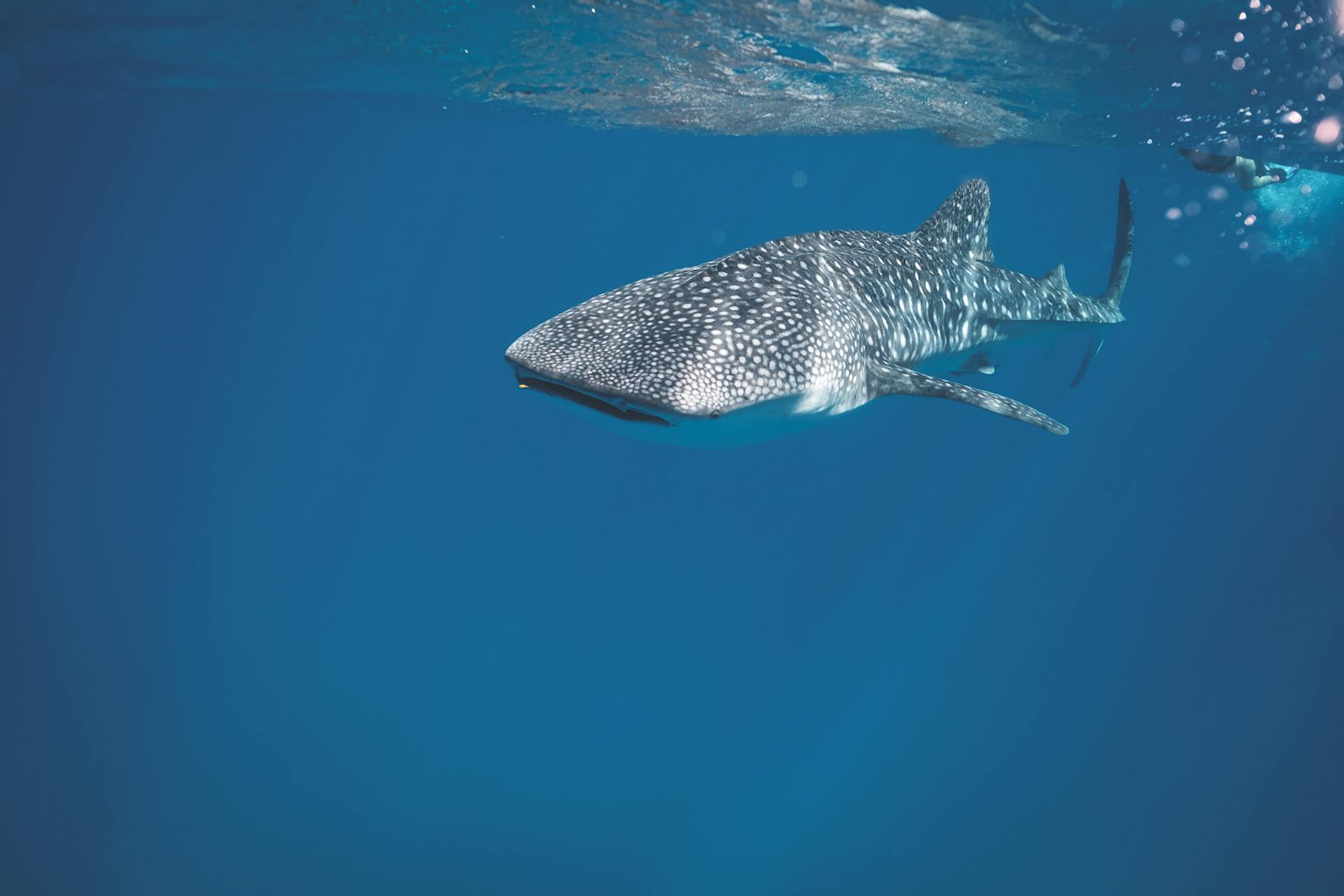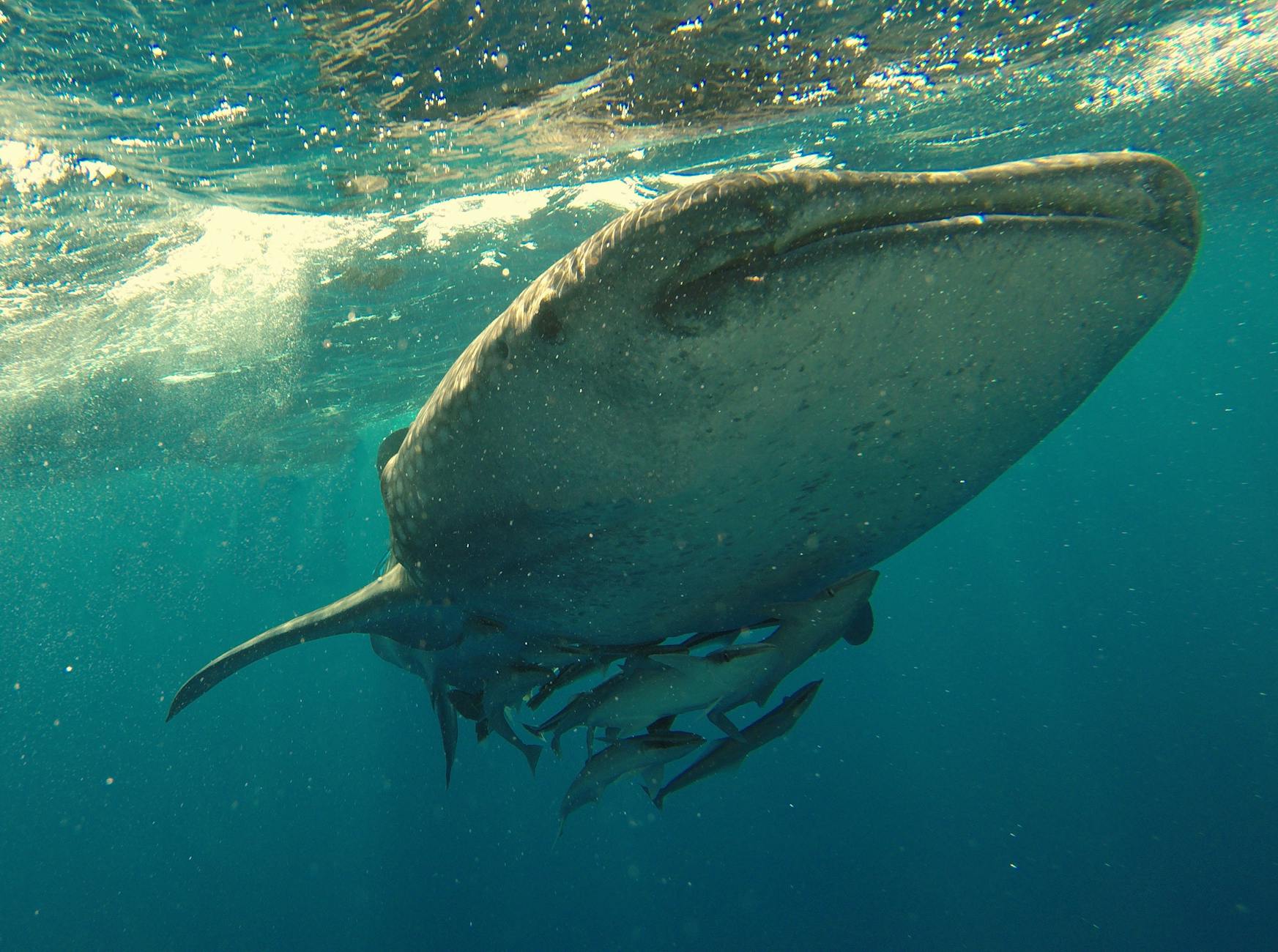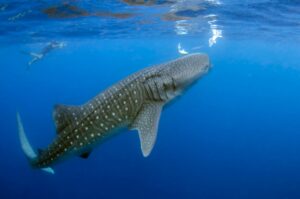What is the largest Shark in the World? Is a shark a mammal or a fish? Sharks have always fascinated us. These ancient creatures are powerful, graceful, and often massive. Among over 500 shark species, a select few stand out for their colossal size.
Largest Shark in the World
Sharks are fish, not mammals. They belong to a group called elasmobranchs, which also includes rays and skates. Unlike mammals, sharks breathe through gills, have cartilage instead of bones, and are cold-blooded. Here’s a deep dive into the top 10 largest sharks in the world.
1. Whale Shark (Rhincodon typus)
The whale shark is the largest shark on Earth. These gentle giants grow up to 60 feet in length and weigh around 20 tons. Despite their size, they pose no threat to humans, feeding only on plankton, small fish, and microscopic plants.
With their wide mouths, whale sharks filter-feed by swimming with their mouths open, taking in water and filtering out tiny creatures. Whale sharks are found in warm, tropical oceans around the world and are recognized by their beautiful spotted skin patterns.
- Average Length: 40-60 feet
- Weight: Up to 20 tons
- Habitat: Warm tropical seas

2. Basking Shark (Cetorhinus maximus)
The basking shark is the second-largest shark species. It can grow up to 40 feet long and weigh over 6 tons. Like the whale shark, basking sharks are filter-feeders and have no interest in humans as food.
They glide near the ocean’s surface with their mouths open, filtering plankton from the water. Basking sharks are commonly found in the North Atlantic and are known for their slow and peaceful swimming style.
- Average Length: 20-40 feet
- Weight: Up to 6 tons
- Habitat: Temperate oceans
3. Great White Shark (Carcharodon carcharias)
The great white shark is the largest predatory shark and can reach up to 20 feet in length. These sharks are highly efficient hunters, using their powerful bodies and sharp senses to catch seals, fish, and even smaller sharks.
Weighing up to 2.5 tons, great whites can also leap out of the water, displaying incredible strength. They are found in coastal regions worldwide and are especially abundant near South Africa, Australia, and California.
- Average Length: 15-20 feet
- Weight: Up to 2.5 tons
- Habitat: Coastal waters worldwide
4. Tiger Shark (Galeocerdo cuvier)
Tiger sharks are impressive due to their length and unique markings. They can grow up to 18 feet long and weigh as much as 1,800 pounds. Known as “garbage eaters,” tiger sharks consume a wide variety of prey, from fish and birds to sea turtles and trash.
With their dark vertical stripes, these sharks are easily recognizable. They inhabit tropical and subtropical waters around the world, especially in the Pacific Ocean.
- Average Length: 10-18 feet
- Weight: Up to 1,800 pounds
- Habitat: Tropical and subtropical waters
5. Greenland Shark (Somniosus microcephalus)
The Greenland shark is one of the largest cold-water sharks, reaching up to 24 feet in length and weighing over 2,000 pounds. These sharks are unique for their incredibly long lifespan, with some individuals estimated to be over 400 years old.
Greenland sharks are slow swimmers and live in the deep, frigid waters of the North Atlantic and Arctic Oceans. Their diet consists mainly of fish, but they have also been found with large prey like seals.
- Average Length: 16-24 feet
- Weight: Up to 2,000 pounds
- Habitat: North Atlantic and Arctic Oceans
6. Pacific Sleeper Shark (Somniosus pacificus)
Closely related to the Greenland shark, the Pacific sleeper shark can also grow up to 20 feet long. These sharks are rarely seen due to their preference for deep, cold waters along the Pacific Rim.
They move slowly and are known for their quiet, stealthy hunting style. Pacific sleeper sharks feed on squid, fish, and sometimes seals.
- Average Length: 12-20 feet
- Weight: Up to 1.5 tons
- Habitat: Deep Pacific Ocean

7. Bluntnose Sixgill Shark (Hexanchus griseus)
The bluntnose sixgill shark can reach up to 16 feet in length and weigh over 1,300 pounds. These sharks have six gills, unlike most sharks, which have five.
With their prehistoric appearance, bluntnose sixgills are often called “living fossils.” They inhabit deep waters and feed on a variety of prey, including fish, rays, and other sharks.
- Average Length: 10-16 feet
- Weight: Up to 1,300 pounds
- Habitat: Deep oceanic and coastal waters
8. Megamouth Shark (Megachasma pelagios)
The megamouth shark is one of the rarest and most mysterious large sharks. Discovered only in 1976, it can grow up to 18 feet in length. Megamouths have a unique appearance with a massive, circular mouth that helps them feed on plankton and jellyfish.
They are deep-sea dwellers, typically found in tropical and temperate oceans. Because they are rarely seen, little is known about their behavior and life cycle.
- Average Length: 13-18 feet
- Weight: Up to 2,700 pounds
- Habitat: Deep tropical and temperate oceans
9. Hammerhead Shark (Sphyrna mokarran)
The great hammerhead is the largest of the hammerhead species, growing up to 20 feet in length. These sharks are recognizable by their wide, hammer-shaped heads, which enhance their ability to detect prey.
Hammerheads are efficient hunters and are known to prey on fish, squid, and even other sharks. They are often found in warm coastal waters, particularly around coral reefs.
- Average Length: 10-20 feet
- Weight: Up to 1,000 pounds
- Habitat: Warm coastal waters
10. Thresher Shark (Alopias vulpinus)
The thresher shark is known for its unique, elongated tail, which can be as long as its body. Threshers can reach up to 18 feet in length, with about half of that being their tail.
They use this tail to stun prey like fish by whipping it through the water. Thresher sharks are found in both tropical and temperate waters worldwide and are known for their incredible speed and agility.
- Average Length: 10-18 feet
- Weight: Up to 1,100 pounds
- Habitat: Tropical and temperate oceans
FAQ – Shark
Is a shark a mammal or a fish?
Sharks are fish, not mammals. They belong to a group called elasmobranchs, which also includes rays and skates. Unlike mammals, sharks breathe through gills, have cartilage instead of bones, and are cold-blooded.
What is the English name for shark?
The English name for these ocean predators is simply “shark.” The term refers to various species within the Selachimorpha group, known for their streamlined bodies and sharp senses.
What are some facts about sharks?
- Ancient Creatures: Sharks have existed for over 400 million years, predating dinosaurs.
- Cartilaginous Skeleton: Unlike most fish, sharks have skeletons made of cartilage, making them lighter and more flexible.
- Keen Senses: Sharks have excellent senses, especially smell, allowing them to detect tiny amounts of blood in the water.
- Variety of Sizes: Sharks range from the small dwarf lantern shark (about 6 inches) to the massive whale shark, which can reach 60 feet.
- Vital Role in Ecosystems: As apex predators, sharks help maintain balance in marine ecosystems by controlling fish populations.
Do sharks lay eggs?
Yes, some sharks lay eggs, but not all. There are three main reproductive methods among sharks:
- Oviparous (Egg-Laying): Some species, like the horn shark and catshark, lay eggs with protective casings, often called “mermaid’s purses.”
- Ovoviviparous (Egg Hatching Inside): Some sharks, like sand tiger sharks, hatch eggs internally, and pups are born live.
- Viviparous (Live Birth): Other sharks, like bull sharks and hammerheads, give birth to live young after nourishing them through a placenta-like connection.
Conclusion
The largest sharks in the world are awe-inspiring in their sheer size and diversity. From the gentle whale shark to the agile thresher shark, each of these species showcases a unique adaptation to life in the ocean. Despite their size, most of these sharks pose little to no threat to humans.



Pingback: How Many Teeth Does a Shark Have? A Deep Dive into Shark Dentition - Correct Responses